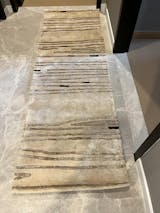Artifacts as Storytellers

Travel draws me to communities of craftspeople. I look at the work they make now. I listen to stories of how their designs came to be, where they get raw materials, and who taught them how to make it. As I prod them to trace back who started it, the storyline transforms from know-how to family history. At some point, memory fails. The human brain is known to lose, twist, alter and replace parts of a story. Folklore is a compounding of distorted memories. Before the dawn of books profoundly changed the course of knowledge preservation, there is another storytelling aid that early communities used. It is the artifact. Old objects can be an enduring keeper of family stories.
Learning about ethnic textiles brought me to a peculiar tribe in Northern Philippines, the Bontoc people. I acquired an early 20th-century ceremonial tribal artifact, an akusan belt of the Bontoc people. Fascinating how one small antique can tell the story of an entire tribe.

A Bontoc woman’s belt, called an akusan, consists of a handwoven band of indigo dyed linen cloth strung with giant conus shells, small gastropod shells and bones. It is worn around the waist like a belt. The pouch formed by smaller shells is worn at the front. Some versions of the pouch are able to store small items inside.
WHO ARE THE BONTOCS?

The word Bontoc came from two morphemes, bun which means 'heap' and tuk which means 'top'. Together, it means 'mountain people'. They descend from hunter-gatherer Polynesian tribes and settle in the Cordillera region, northern Philippines. Cordillera is characterized by the rice terraces carved laboriously over centuries by ethnic tribes, including Bontoc people.
WHAT DO THEY DO FOR A LIVING?

Other than farming rice, the Bontoc are excellent potters, forgers of shields and battle axes, and weavers of baskets and wooden cages to keep fowl safe at night.

Tattooing is an important part of their heritage. Fatoc are chest tattoos, signifying they are head hunters. Pong-o are tattooed arms of men and women. Fatek areall other tattoos of men and women.

The akusan belt, although frayed by time, demonstrates a glimpse of the Bontoc culture of weaving textiles.

DO THEY BELIEVE IN GOD?
Bontoc believe in anitos, or spirits of their ancestors. During the time the Spanish came and introduced Christianity to Filipinos, the Bontoc tribe chose to retain their religion. Their deity and centre of the creation myth are Lumawig, The Great Spirit.

The Miracles of Lumawig. Artwork by Rodel Tapaya











